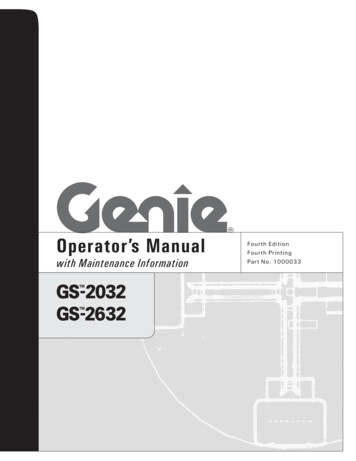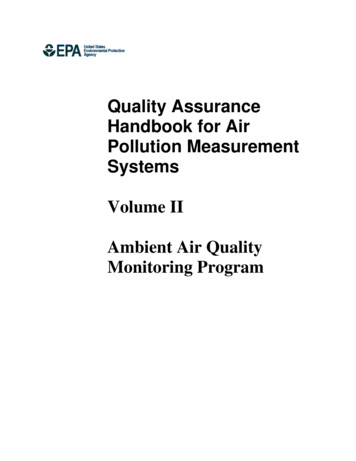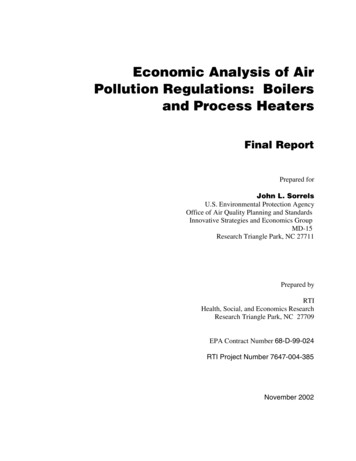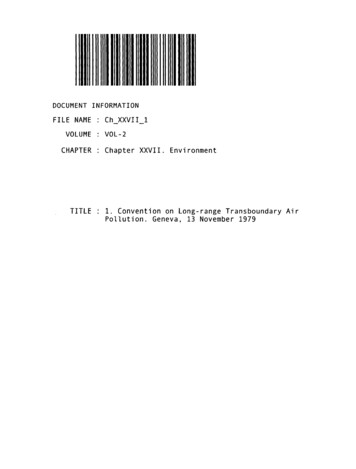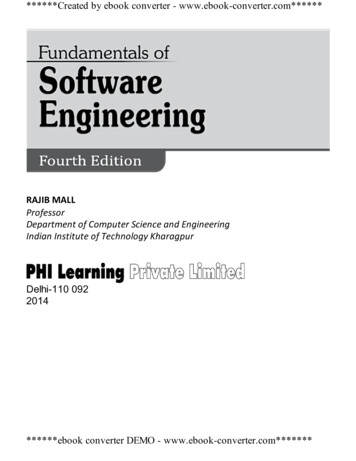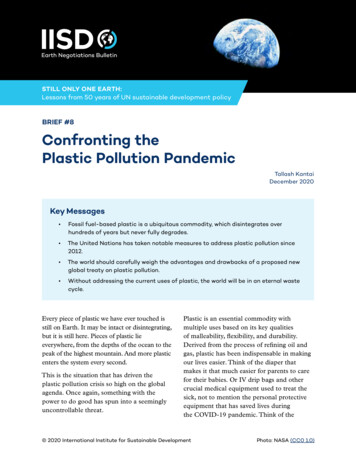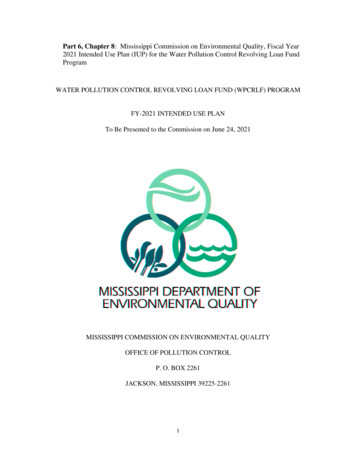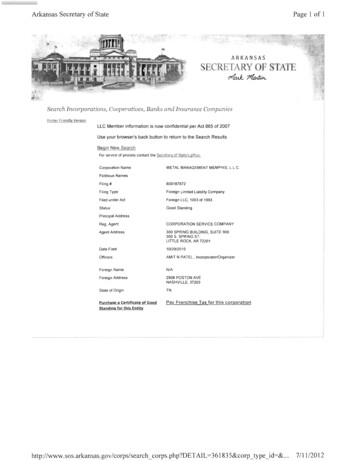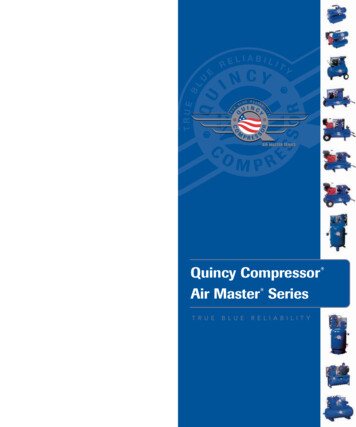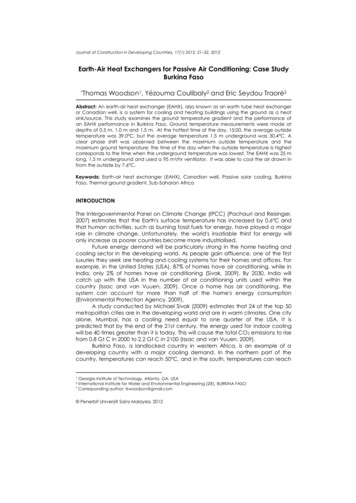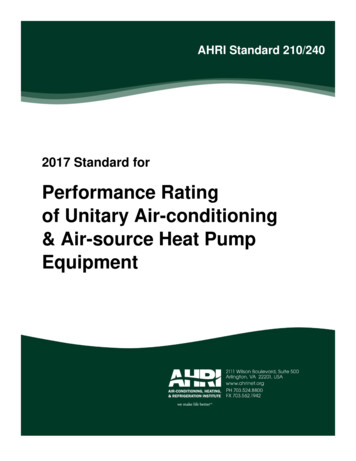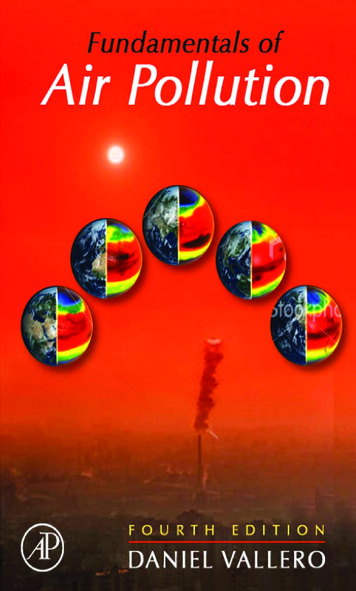
Transcription
FundamentalsofAir PollutionFOURTH EDITION
Authors of Third EditionRICHARD W. BOUBELDepartment of Mechanical EngineeringOregon State UniversityCorvallis, OregonDONALD L. FOXDepartment of Environmental ScienceSchool of Public HealthUniversity of North CarolinaChapel Hill, North CarolinaD. BRUCE TURNERTrinity Consultants, Inc.Chapel Hill, North CarolinaARTHUR C. STERN(14 March 1909–17 April 1992)
FundamentalsofAir PollutionFOURTH EDITIONDANIEL A. VALLEROCivil and Environmental Engineering DepartmentPratt School of EngineeringDuke UniversityDurham, North CarolinaAMSTERDAM BOSTON HEIDELBERG LONDON NEW YORK OXFORDPARIS SAN DIEGO SAN FRANCISCO SINGAPORE SYDNEY TOKYOAcademic Press is an imprint of Elsevier
Academic Press is an imprint of Elsevier30 Corporate Drive, Suite 400, Burlington, MA 01803, USA525 B Street, Suite 1900, San Diego, California 92101-4495, USA84 Theobald’s Road, London WC1X 8RR, UK This book is printed on acid-free paper.First Edition 1973Second Edition 1984Third Edition 1994Fourth Edition 2008Copyright 2008, Elsevier Inc. All rights reserved.No part of this publication may be reproduced or transmitted in any form or by any means,electronic or mechanical, including photocopy, recording, or any information storage andretrieval system, without permission in writing from the publisher.Permissions may be sought directly from Elsevier’s Science & Technology RightsDepartment in Oxford, UK: phone: ( 44) 1865 843830, fax: ( 44) 1865 853333;e-mail: permissions@elsevier.com. You may also complete your request online via the Elsevierhomepage (http://elsevier.com), by selecting “Support & Contact” then “Copyright andPermission” and then “Obtaining Permissions.”Library of Congress Cataloging-in-Publication DataVallero, Daniel A.Fundamentals of air pollution / Daniel A. Vallero — 4th ed.p. cm.Includes index.ISBN 978-0-12-373615-4 (alk. paper)1. Air—Pollution. I. Title.TD883.V25 2007628.5 3—dc222007028062British Library Cataloguing-in-Publication DataA catalogue record for this book is available from the British LibraryISBN: 978-0-12-373615-4For information on all Academic Press publicationsvisit our website at www.books.elsevier.comTypeset by Charon Tec Ltd (A Macmillan Company), Chennai, Indiawww.charontec.comPrinted and bound in the USA07080910987654321
Dedicated to the four authors of the previous edition.I am standing on the shoulders of giants.
This page intentionally left blank
ContentsPreface to the Third EditionPreface to the Fourth EditionxviixxiPart IAir Pollution Essentials1The Changing Face of Air PollutionI. Defining Air PollutionII. The Emergence of Air Pollution Science, Engineering, andTechnologyIII. Air Pollution Before the Industrial RevolutionIV. Air Pollution and the Industrial RevolutionV. Recent Air PollutionVI. The 1980sVII. Recent HistoryVIII. The FutureFurther ReadingSuggested ReadingQuestionsvii37374042474849495151
viii2ContentsThe Earth’s AtmosphereI. The AtmosphereII. Baseline Conditions: Unpolluted AirIII. What is Air Pollution?IV. Particulate MatterV. ConceptsReferencesSuggested ReadingQuestions35253585971767676Scales of the Air Pollution ProblemI. LocalII. UrbanIII. RegionalIV. ContinentalV. GlobalSuggested ReadingQuestions77787980858687Part IIThe Physics and Chemistry of Air Pollution4Air Pollution PhysicsI. Mechanics of Air PollutionII. Fluid PropertiesQuestions5The Physics of the AtmosphereI. EnergyII. MotionIII. Energy-Motion RelationshipsIV. Local Wind SystemsV. General CirculationReferencesSuggested r Pollution Systems and ProcessesI. Chemical Processes in Air Pollution154
ContentsII. Air Pollution ChemodynamicsReferencesSuggested ReadingQuestionsix160197197198Characterizing Air Pollution7I.II.III.IV.Relationship Between Physics and ChemistryBasic Chemical ConceptsExpressions of Chemical CharacteristicsElectromagnetic Radiation, Electron Density, Orbitals,and ValenceV. Organic ChemistryVI. Introduction to Atmospheric ChemistryVII. Heterogeneous ReactionsVIII. Scavenging and Removal from the AtmosphereReferencesSuggested ir Quality8I. Averaging TimeII. CyclesIII. Primary and Secondary PollutantsIV. Measurement SystemsV. Air Quality LevelsReferencesSuggested ReadingQuestions2672702732752772952952959 The Philosophy of Air Pollution ControlI. Strategy and Tactics: The Air Pollution SystemII. Episode ControlIII. Air Quality Management Control StrategyIV. Alternative Control StrategiesV. Economic ConsiderationsReferencesSuggested ReadingQuestions29630130630931031131131110 Sources of Air PollutionI. GeneralII. CombustionIII. Stationary Sources313319325
xContentsIV.V.VI.VII.Mobile SourcesAir Toxics SourcesEmission InventoryAn International Perspective: Differences inTime and SpaceVIII. ODORS: More than just a NuisanceReferencesSuggested ReadingQuestions336337343346351353353354Part IIIRisks from Air Pollution11 Effects on Health and Human WelfareI. Air–Water–Soil InteractionsII. Total Body BurdenIII. The Human Respiratory SystemIV. Impact of Air Pollution on HumansV. Impact of Odor on HumansReferencesSuggested ReadingQuestions35936537838139439539539612 Effects on Vegetation and AnimalsI. Injury versus DamageII. Effects on Vegetation and CropsIII. Effects on ForestsIV. Effects on AnimalsReferencesSuggested ReadingQuestions39739940340841141241213 Effects on Materials and StructuresI. Effects on MetalsII. Effects on StoneIII. Effects on Fabrics and DyesIV. Effects on Leather, Paper, Paint, and GlassV. Effects on RubberReferencesSuggested ReadingQuestions413416417419420421422422
Contentsxi14 Effects on the Atmosphere, Soil, and Water BodiesI. The Physics of VisibilityII. Formation of Atmospheric HazeIII. Effects of Atmospheric HazeIV. VisibilityV. Acidic DepositionVI. Effects of Acidic DepositionReferencesSuggested ReadingQuestions42343043343443543843944044115 Long-Term Effects on the PlanetI. Global Climate ChangeII. Ozone HolesReferencesSuggested ReadingQuestions442451453454454Part IVThe Measurement and Monitoring of Air Pollution16 Ambient Air SamplingI. Elements of a Sampling SystemII. Sampling Systems for Gaseous PollutantsIII. Sampling Systems for Particulate PollutantsIV. Passive Sampling SystemsV. Sampler Siting RequirementsVI. Sampling for Air ToxicsReferencesSuggested ReadingQuestions45745946346646846947047047017 Ambient Air Pollutants: Analysis and MeasurementI. Analysis and Measurement of Gaseous PollutantsII. Analysis and Measurement of Particulate PollutantsIII. Analysis and Measurement of OdorsIV. Analysis and Measurement of VisibilityV. Analysis and Measurement of Acidic DepositionReferencesSuggested ReadingQuestions472487490492496497498498
xiiContents18 Air Pollution Monitoring and SurveillanceI. Stationary Monitoring NetworksII. Mobile Monitoring and SurveillanceIII. Remote SensingIV. Personal MonitoringV. Quality AssuranceVI. Data Analysis and DisplayReferencesSuggested ReadingQuestions50050350550650851051351351319 Air Pathways from Hazardous Waste SitesI. IntroductionII. Multimedia TransportIII. Contaminant Fate AnalysisIV. ModelingV. Assessment of a Hazardous Waste SiteReferencesSuggested ReadingQuestions515516516524525533533533Part VAir Pollution Modeling20 The Meteorological Bases of Atmospheric PollutionI. VentilationII. StagnationIII. Meteorological Conditions during Historic PollutionEpisodesIV. Effects of Pollution on the AtmosphereV. Removal MechanismsReferencesSuggested ReadingQuestions53753954054654755055155121 Transport and Dispersion of Air PollutantsI.II.III.IV.Wind VelocityTurbulenceEstimating Concentrations from Point SourcesDispersion Instrumentation552554557566
ContentsV. Atmospheric TracersVI. Concentration Variation with Averaging TimeReferencesSuggested ReadingQuestionsxiii57157657857957922 Air Pollution Modeling and PredictionI. Plume RiseII. Modeling TechniquesIII. Modeling Nonreactive PollutantsIV. Modeling Pollutant TransformationsV. Modeling Air PollutantsVI. Model Performance, Accuracy, and UtilizationReferencesSuggested ReadingQuestions58258558759059362763363663723 Air Pollution ClimatologyI. Sources of DataII. RepresentativenessIII. Frequency of Atmospheric StagnationsIV. Ventilation ClimatologyV. Wind and Pollution RosesReferencesSuggested ReadingQuestions638641646647650654655655Part VIThe Regulatory Control of Air Pollution24 Air Quality Criteria and StandardsI. Air Quality CriteriaII. Conversion of Effects Data and Criteria to StandardsIII. Conversion of Physical Data and Criteria to StandardsIV. Conversion of Biological Data and Criteria to StandardsV. Air Quality StandardsSuggested ReadingQuestions65965966967167267767825 Indoor Air QualityI. Changing TimesII. Factors Influencing Indoor Air Quality679680
xivContentsIII. Indoor Air PollutantsIV. Effects of Indoor Air PollutantsV. Control of Indoor Air PollutantsReferencesSuggested ReadingQuestions68268568769269269226 Regulating Air PollutionI. IntroductionII. TitlesReferencesSuggested ReadingQuestions69669770670670627 Emission StandardsI. Subjective StandardsII. Objective StandardsIII. Types of Emission StandardsIV. Variant Forms of Emission StandardsV. Means for Implementing Emission StandardsReferencesSuggested ReadingQuestions70770971371371572172172228 The Elements of Regulatory ControlI. Control of New Stationary SourcesII. Control of Existing Stationary SourcesIII. Control of Mobile SourcesIV. Air Quality Control RegionsV. Tall Stacks and Intermittent and Supplementary ControlSystemsReferencesSuggested ReadingQuestions72472572672772872972972929 Organization for Air Pollution ControlI. FunctionsII. OrganizationIII. FinanceIV. Advisory GroupsSuggested ReadingsQuestions730733736737738739
ContentsxvPart VIIPreventing and Controlling Air Pollution30 Preventing Air PollutionI. IntroductionII. SustainabilityIII. Green Engineering and SustainabilityIV. Life Cycle AnalysisV. Pollution PreventionVI. Motivations for Practicing Green EngineeringVII. Future PeopleReferencesSuggested ReadingQuestions74374374475375676176777077277231 Engineering Control ConceptsI. IntroductionII. Process ChangeIII. Fuel ChangeIV. Pollution RemovalV. Disposal of PollutantsReferencesSuggested ReadingQuestions77477677777878078478478432 Control Devices, Technologies, and SystemsI. IntroductionII. Removal of Dry PMIII. Removal of Liquid Droplets and MistsIV. Removal of Gaseous PollutantsV. Removal of OdorsReferencesSuggested ReadingQuestions78679480781082182282382333 Control of Hazardous Air PollutantsI.II.III.IV.V.Air Quality and Hazardous WastesPre-control ConsiderationsContaminant Treatment and Control ApproachesThermal Treatment ProcessesThermal Destruction Systems825830832835839
xviContentsVI. Destruction RemovalVII. Other Thermal ProcessesVIII. Indirect Air ImpactsReferencesSuggested ReadingQuestions84484584884985085034 Control of Stationary SourcesI. IntroductionII. Energy, Power, and IncinerationIII. Chemical and Metallurgical IndustriesIV. Agriculture and Forest Products IndustriesV. Other Industrial ProcessesReferencesSuggested ReadingQuestions85285385987287888388488535 Control of Mobile SourcesI. IntroductionII. Gasoline-Powered VehiclesIII. Diesel-Powered VehiclesIV. Gas Turbines and Jet EnginesV. Alternatives to Existing Mobile SourcesReferencesSuggested ReadingQuestions88688688988989189389389436 Source Sampling and MonitoringI. IntroductionII. Source SamplingIII. Statistics of SamplingIV. The Source TestV. Source MonitoringReferencesSuggested ReadingQuestions89589589789991091591591537 The Future of Air PollutionI. The Good NewsII. Stubborn Problems and Innovative SolutionsIndex917917919
Preface to theThird EditionThe authors of this book include a chemist (Donald L. Fox), a meteorologist (D. Bruce Turner), and a mechanical engineer (Richard W. Boubel). This1:1:1 ratio has some relevance in that it approximates the ratio of those professionally involved in the field of air pollution. In the environmental protection and management field, the experience of the recent past has been thatphysicists and electrical engineers have been most attracted to the radiation,nuclear, and noise areas; biologists and civil engineers to the aquatic andsolid waste areas; chemists, meteorologists, and chemical and mechanicalengineers to the area of air pollution and its control. These remarks are notintended to exclude all others from the party (or from this course). The control of air pollution requires the combined efforts of all the professions mentioned, in addition to the input of physicians, lawyers, and social scientists.However, the professional mix of the authors, and their expectation of anot-too-dissimilar mix of students using this book, forewarns the tenor of itscontents and presentation.Although this book consists of six parts and three authors, it is not to be considered six short books put together back-to-back to make one large one. Byand large, the several parts are the work of more than one author. Obviously,the meteorologist member of the author team is principally responsible for thepart of the book concerned with the meteorology of air pollution, the chemistauthor for the chapters on chemistry, and the engineer author for those onengineering. However, as you will see, no chapters are signed, and all authorsxvii
xviiiPreface to the Third Editionaccept responsibility for the strengths and weaknesses of the chapters and forthe book as a whole.In the 20 years since publication of the first edition of Fundamentals of AirPollution (1973), and the 9 years since the second edition (1984), the fundamentals have not changed. The basic physics, chemistry, and engineering are stillthe same, but there is now a greater in-depth understanding of their application to air pollution. This edition has been edited, revised, and updated toinclude the new technology available to air pollution practitioners. Its contentsare also influenced
Authors of Third Edition RICHARD W. BOUBEL Department of Mechanical Engineering Oregon State University Corvallis, Oregon DONALD L. FOX Department of Environmental Science School of Public Health University of North Carolina Chapel Hill, North Carolina D. BRUCE TURNER Trinity Consultants, Inc. Chapel Hill, North Carolina ARTHUR C. STERN (14 March 1909–17 April 1992) Fundamentals of
